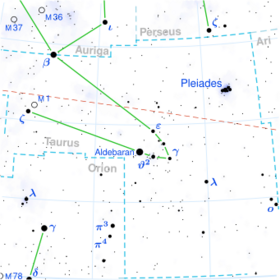Astronomy:Nu Tauri
| Observation data Equinox J2000.0]] (ICRS) | |
|---|---|
| Constellation | Taurus |
| Right ascension | 04h 03m 09.37966s[1] |
| Declination | +05° 59′ 21.4792″[1] |
| Apparent magnitude (V) | 3.91[2] |
| Characteristics | |
| Evolutionary stage | main sequence[3] |
| Spectral type | A0.5Va[4] |
| U−B color index | +0.06[5] |
| B−V color index | +0.03[5] |
| Astrometry | |
| Radial velocity (Rv) | −5.7±0.9[6] km/s |
| Proper motion (μ) | RA: +4.72[1] mas/yr Dec.: −3.78[1] mas/yr |
| Parallax (π) | 27.89 ± 0.19[1] mas |
| Distance | 116.9 ± 0.8 ly (35.9 ± 0.2 pc) |
| Absolute magnitude (MV) | 1.14[2] |
| Details | |
| Mass | 2.25±0.01[3] M☉ |
| Radius | 2.87+0.16 −0.31[7] R☉ |
| Luminosity | 28.1±0.4[7] L☉ |
| Surface gravity (log g) | 4.02[8] cgs |
| Temperature | 7,836+464 −203[7] K |
| Metallicity [Fe/H] | −0.19±0.08[9] dex |
| Rotational velocity (v sin i) | 83[3] km/s |
| Age | 206[8] Myr |
| Other designations | |
| Database references | |
| SIMBAD | data |
ν Tauri, Latinized as Nu Tauri, is a single[11] star in the zodiac constellation of Taurus. It is a white-hued star and is visible to the naked eye with an apparent visual magnitude of +3.91.[2] This object is located 117 light years from the Sun based on parallax,[1] but is drifting closer with a radial velocity of −6 km/s.[6] It is predicted to come to within roughly 18.4 ly of the Sun in around five million years.[12]
This object is an A-type main-sequence star with a stellar classification of A0.5Va.[4] It is 206[8] million years old and is rotating with a projected rotational velocity of 83 km/s.[3] The star has 2.25[3] times the mass of the Sun and 2.87[7] times the Sun's radius. It is radiating 28 times the luminosity of the Sun from its photosphere at an effective temperature of 7,836 K.[7]
Nu Tauri has a magnitude 9.21 visual companion at an angular separation 15.9″.[13]
References
- ↑ 1.0 1.1 1.2 1.3 1.4 1.5 Van Leeuwen, F. (2007). "Validation of the new Hipparcos reduction". Astronomy and Astrophysics 474 (2): 653–664. doi:10.1051/0004-6361:20078357. Bibcode: 2007A&A...474..653V. Vizier catalog entry
- ↑ 2.0 2.1 2.2 Anderson, E.; Francis, Ch. (2012). "XHIP: An extended hipparcos compilation". Astronomy Letters 38 (5): 331. doi:10.1134/S1063773712050015. Bibcode: 2012AstL...38..331A. Vizier catalog entry
- ↑ 3.0 3.1 3.2 3.3 3.4 Zorec, J.; Royer, F. (2012). "Rotational velocities of A-type stars". Astronomy & Astrophysics 537: A120. doi:10.1051/0004-6361/201117691. Bibcode: 2012A&A...537A.120Z. Vizier catalog entry
- ↑ 4.0 4.1 Gray, R. O. et al. (2006). "Contributions to the Nearby Stars (NStars) Project: Spectroscopy of Stars Earlier than M0 within 40 pc--The Southern Sample". The Astronomical Journal 132 (1): 161–170. doi:10.1086/504637. Bibcode: 2006AJ....132..161G.
- ↑ 5.0 5.1 Mallama, A. (2014). "Sloan Magnitudes for the Brightest Stars". The Journal of the American Association of Variable Star Observers 42 (2): 443. Bibcode: 2014JAVSO..42..443M.Vizier catalog entry
- ↑ 6.0 6.1 Wilson, R. E. (1953). "General Catalogue of Stellar Radial Velocities". Carnegie Institute Washington D.C. Publication (Carnegie Institution for Science). Bibcode: 1953GCRV..C......0W.
- ↑ 7.0 7.1 7.2 7.3 7.4 Brown, A. G. A. (August 2018). "Gaia Data Release 2: Summary of the contents and survey properties". Astronomy & Astrophysics 616: A1. doi:10.1051/0004-6361/201833051. Bibcode: 2018A&A...616A...1G. Gaia DR2 record for this source at VizieR.
- ↑ 8.0 8.1 8.2 David, Trevor J.; Hillenbrand, Lynne A. (2015). "The Ages of Early-Type Stars: Strömgren Photometric Methods Calibrated, Validated, Tested, and Applied to Hosts and Prospective Hosts of Directly Imaged Exoplanets". The Astrophysical Journal 804 (2): 146. doi:10.1088/0004-637X/804/2/146. Bibcode: 2015ApJ...804..146D. Vizier catalog entry
- ↑ Gáspár, András et al. (2016). "The Correlation between Metallicity and Debris Disk Mass". The Astrophysical Journal 826 (2): 171. doi:10.3847/0004-637x/826/2/171. Bibcode: 2016ApJ...826..171G.
- ↑ "nu Tau". SIMBAD. Centre de données astronomiques de Strasbourg. http://simbad.u-strasbg.fr/simbad/sim-basic?Ident=nu+Tau.
- ↑ Eggleton, P. P.; Tokovinin, A. A. (September 2008). "A catalogue of multiplicity among bright stellar systems". Monthly Notices of the Royal Astronomical Society 389 (2): 869–879. doi:10.1111/j.1365-2966.2008.13596.x. Bibcode: 2008MNRAS.389..869E.
- ↑ Bailer-Jones, C. A. L. (March 2015). "Close encounters of the stellar kind". Astronomy & Astrophysics 575: 13. doi:10.1051/0004-6361/201425221. A35. Bibcode: 2015A&A...575A..35B.
- ↑ Mason, Brian D. et al. (2001). "The 2001 US Naval Observatory Double Star CD-ROM. I. The Washington Double Star Catalog". The Astronomical Journal 122 (6): 3466. doi:10.1086/323920. Bibcode: 2001AJ....122.3466M. Vizier catalog entry
 |


